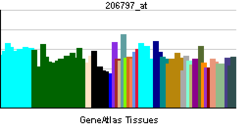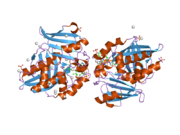- N-acetyltransferase 2
-
N-acetyltransferase 2 (arylamine N-acetyltransferase) 
PDB rendering based on 2pfr.Available structures PDB 2pfr Identifiers Symbols NAT2; AAC2; PNAT External IDs OMIM: 612182 MGI: 97279 HomoloGene: 115468 GeneCards: NAT2 Gene EC number 2.3.1.5 Gene Ontology Molecular function • arylamine N-acetyltransferase activity
• acetyltransferase activity
• transferase activityCellular component • cytoplasm
• cytosol
• cytosolBiological process • xenobiotic metabolic process
• metabolic processSources: Amigo / QuickGO RNA expression pattern 
More reference expression data Orthologs Species Human Mouse Entrez 10 17960 Ensembl ENSG00000156006 ENSMUSG00000025588 UniProt P11245 Q546L3 RefSeq (mRNA) NM_000015.2 NM_008673.1 RefSeq (protein) NP_000006.2 NP_032699.1 Location (UCSC) Chr 8:
18.25 – 18.26 MbChr 8:
70.01 – 70.02 MbPubMed search [1] [2] N-acetyltransferase 2 (arylamine N-acetyltransferase), also known as NAT2, is an enzyme which in humans is encoded by the NAT2 gene.[1]
Contents
Function
This gene encodes a type of N-acetyltransferase. The NAT2 isozyme functions to both activate and deactivate arylamine and hydrazine drugs and carcinogens. Polymorphisms in this gene are responsible for the N-acetylation polymorphism in which human populations segregate into rapid, intermediate, and slow acetylator phenotypes. Polymorphisms in NAT2 are also associated with higher incidences of cancer and drug toxicity. A second arylamine N-acetyltransferase gene (NAT1) is located near NAT2.[2]
Phenotype prediction
The NAT2 acetylator phenotype can be inferred from NAT2 genotype (a combination of SNPs observed in a given individual).[3][4]
References
- ^ Vatsis KP, Weber WW, Bell DA, Dupret JM, Evans DA, Grant DM, Hein DW, Lin HJ, Meyer UA, Relling MV (February 1995). "Nomenclature for N-acetyltransferases". Pharmacogenetics 5 (1): 1–17. doi:10.1097/00008571-199502000-00001. PMID 7773298.
- ^ "Entrez Gene: NAT2 N-acetyltransferase 2 (arylamine N-acetyltransferase)". http://www.ncbi.nlm.nih.gov/sites/entrez?Db=gene&Cmd=ShowDetailView&TermToSearch=10.
- ^ "NAT2PRED: a computational predictor of the human N-AcetylTransferase-2 (NAT2) acetylator phenotype". State University of New York – Albany. http://nat2pred.rit.albany.edu/. Retrieved 2009-04-30.
- ^ Kuznetsov IB, McDuffie M, Moslehi R (May 2009). "A web server for inferring the human N-acetyltransferase-2 (NAT2) enzymatic phenotype from NAT2 genotype". Bioinformatics (Oxford, England) 25 (9): 1185–6. doi:10.1093/bioinformatics/btp121. PMC 2672629. PMID 19261719. http://www.pubmedcentral.nih.gov/articlerender.fcgi?tool=pmcentrez&artid=2672629.
Further reading
- Vatsis KP, Weber WW, Bell DA, et al. (1995). "Nomenclature for N-acetyltransferases.". Pharmacogenetics 5 (1): 1–17. doi:10.1097/00008571-199502000-00001. PMID 7773298.
- Windmill KF, McKinnon RA, Zhu X, et al. (1997). "The role of xenobiotic metabolizing enzymes in arylamine toxicity and carcinogenesis: functional and localization studies.". Mutat. Res. 376 (1-2): 153–60. doi:10.1016/S0027-5107(97)00038-9. PMID 9202751.
- Lan Q, Rothman N, Chow WH, et al. (2003). "No apparent association between NAT1 and NAT2 genotypes and risk of stomach cancer.". Cancer Epidemiol. Biomarkers Prev. 12 (4): 384–6. PMID 12692115.
- Ochs-Balcom HM, Wiesner G, Elston RC (2007). "A meta-analysis of the association of N-acetyltransferase 2 gene (NAT2) variants with breast cancer.". Am. J. Epidemiol. 166 (3): 246–54. doi:10.1093/aje/kwm066. PMID 17535831.
- Sanderson S, Salanti G, Higgins J (2007). "Joint effects of the N-acetyltransferase 1 and 2 (NAT1 and NAT2) genes and smoking on bladder carcinogenesis: a literature-based systematic HuGE review and evidence synthesis.". Am. J. Epidemiol. 166 (7): 741–51. doi:10.1093/aje/kwm167. PMID 17675654.
PDB gallery Categories:- Human proteins
- Chromosome 8 gene stubs
Wikimedia Foundation. 2010.

